Friends of Padre Steve’s World,
I am tired as a result I am posting something out of my archives today. It’s actually a paper I wrote for one of my Masters Degree Classes back in 2009 that I decided to post on the site. Since then I have done much more study on the battle from other sources, many more critical of Manstein and revealing of the crimes committed by his troops on the Eastern Front. I could probably do more with it except to do more biographical work on Von Manstein, but I don’t expect that I will at them moment because I already know much about his strategic and battlefield brilliance, and enough about his character for now. For me character matters more than battlefield brilliance.
The article deals with the crisis that the German armies faced following Stalingrad and how Field Marshal Erich von Manstein succeeded in talking Adolf Hitler out of certain defeat and inflicting a massive defeat on the now overconfident and over extended Soviet armies.
Von Manstein was a brilliant strategist, his bold plan to conquer France in 1940 was a masterpiece, as was his conduct of combat operations on the Eastern Front until his relief in March of 1944 for withdrawing (and saving) his armies from Soviet destruction without Hitler’s approval. Von Manstein was a brilliant commander at the operational level of war, but he also gave his approval and support to war crimes committed by the SS Einsatzgruppen against the Jews and others in his area of operations. He believed that Bolshevism and the Jews were linked, thus in his codicil to Von Reichenau’s Severity Order in November 1941 stated:
“Jewish Bolshevik system must be wiped out once and for all and should never again be allowed to invade our European living space … It is the same Jewish class of beings who have done so much damage to our own Fatherland by virtue of their activities against the nation and civilisation, and who promote anti-German tendencies throughout the world, and who will be the harbingers of revenge. Their extermination is a dictate of our own survival.”
This article depicts Manstein at his zenith when even Hitler was forced to give in to his logic, but barely a year later Hitler relieved him of command as Manstein remained committed to a mobile defense surrendering space while attempting to maximize Soviet casualties.
Manstein is a complex character, he defended German Jews in the Reichswehr yet went on to cooperate in the deaths of hundreds of thousands of Jews in Russia. There is a decent possibility that he had some Jewish ancestry, he opposed the Aryan Paragraph which banned Jews from serving in the German armed forces telling General Ludwig Beck that anyone who had volunteered to serve had already proved their worth. Part of this may have been to protect mixed race grand-nephews who were already serving in the Reichswehr and his concern that he might have Jewish blood.
The SS launched an investigation regarding this, but never completed it. The results of what they found or did not find are unknown. It makes me wonder if I could make an extended trip to Germany and do some research on the topic. This is because based on all of his other anti-Semitic beliefs, if he really did not believe that the Germans had murdered the number of Jews that they did as was recorded in his post-war testimony. Almost all of Von Manstein’s criticisms of Hitler were restricted to the conduct of the war, not the political and moral aspects that formed the heart of Nazi policy and the Holocaust.
Though Manstein knew that Hitler was leading Germany to destruction, he rebuffed his colleagues who attempted to kill Hitler and the overthrow the Nazi regime. Had he supported them he might have brought others with him.
Likewise, though he was tried and convicted of war crimes he was given an early release from prison at the behest of Winston Churchill, Konrad Adenauer and other notables. After his release he went on to advise the German government on the organization of the new Bundeswehr, and become something of a celebrity among military history students, and military officers, especially Britain and the United States.
Manstien’s post war writings were highly critical of Hitler and for the most part he succeeded in rehabilitating himself, in large part with the help of Western military historians and theorists of mobile warfare. These men looked at the military aspects of the war and built what amounted to a cult around Manstein and German military and other high ranking Wehrmacht critics of Hitler, with scant regard to the murderous policies of the Nazis, and the personal responsibility and participation of many of them in carrying out Hitler’s decrees. When Manstein died in 1973 at the age of 85 he was the last surviving German Field Marshal and was buried with full military honors.
While it is true that Manstein was a brilliant commander and strategist, he aided and abetted one of the most criminal regimes in history. The German magazine Der Spiegel wrote of him: “He assisted in the march to catastrophe—misled by a blind sense of duty.”
This is something that all military professionals have to guard against. I am less concerned about senior American military leaders than I was last summer, but there are men and women who though in military had or have a higher alliance to for er President Trump than the Constitution as was demonstrated on 6 January. For the moment my fears are assuaged, but I do know that many self-styled “Patriots” more enamored with White Nationalist, Authoritarian and theocratic beliefs then they are in our Constitution and democracy are serving throughout our military. They include enlisted members, officers, probably including a number of General and Flag Officers, and DOD civilians in high ranking positions. In fact Trump appointed quite a few political hacks to permanent civil service positions in DOD, State, Homeland Security and other important positions before he left office. The Biden administration is attempting to move them to positions where they cannot do damage but they are in place.
So, until tomorrow,
Peace,
Padre Steve+
Introduction
After Stalingrad the Soviets followed up on their success and attempted to entrap the rest of Army Group South. Field Marshall von Manstein attempted to save the Army Group and perhaps prevent the Soviets from collapsing the entire German front.
 Manstein (center) planning at the front
Manstein (center) planning at the front
Chaos and Peril in the South
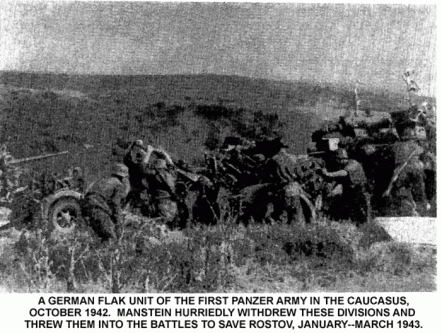
The most dangerous threat that Manstein faced was to Army Group A in the Caucasus. This Army Group “found itself in danger of being cut off, forcing an immediate withdraw.”[v] Disaster was averted by the desperate holding actions of Manstein’s meager forces, Army detachment’s Fretter-Pico and Hollidt, and winter conditions that made “offensive operations extraordinarily difficult, even for the hardiest Soviet troops.”[vi]
A smart withdraw executed by General von Kleist managed to extricate the Army group “just as the Stalingrad forces collapsed.”[vii] To parry the Soviet thrusts the Germans lacked forces to “establish a deeply echeloned defense” and “instead combined maneuver… with stubborn positional defense to give artificial depth to the battlefield. In this way the Germans were able to break major Soviet attacks, preventing catastrophic breakthroughs….”[viii] The timely introduction of a battalion of Tiger tanks prevented the Russians from breaking through to Rostov and “cutting the rail and road lines on which First Panzer Army’s retreat depended.”[ix] Even so the escape of the Army Group was narrow. “In terms of time, space, force, and weather conditions it was an astonishing performance-for which Kleist was made a field-marshal.”[x] With the Russians only 70 kilometers from Rostov and his own forces 650 kilometers from that city Kleist executed a withdraw “which had appeared hardly possible to achieve.”[xi] The divisions extricated by Kleist would be instrumental in the coming weeks as Manstein moved to counter the Soviet offensive.
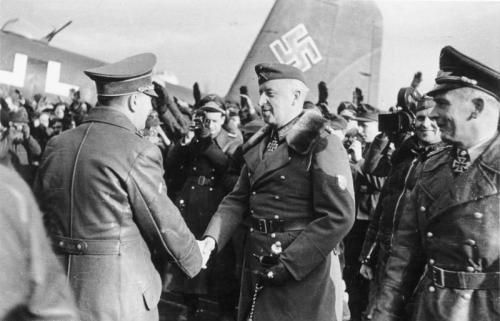
Hitler and Manstein
Despite the successful withdraw the situation was still precarious in early February, Manstein had no effective contact with his left wing, the bulk of which was tied to Kharkov, The Russians had “virtually complete freedom of action across a fifty-mile stretch of the Donetz on either side of Izyum.”[xii] Manstein was hard pressed to “halt the raids of Mobile Group Popov and other exploiting Soviet tank corps in Operation Gallop.”[xiii] Manstein’s forces in the eastern sector had been divided by Russian penetrations, which threatened 1st Panzer Army’s western flank and blocked the Army Group’s main railway line.[xiv]
On 15 February “the SS Panzer Corps withdrew from Kharkov-in spite of orders from Hitler…that the city was to be held to the last.”[xv] SS General Paul Hausser, the corps commander realized that the order to hold Kharkov was impossible and requested permission to withdraw. This was was refused by General Lanz. Under pressure from encircling Russian forces outside and from partisans inside the city, Hausser disobeyed the order and extricated his troops,[xvi] thereby saving thousands of German soldiers and preserved the SS Panzer Corps as a fighting unit.[xvii] Lanz was relieved by Hitler for the loss of Kharkov and although Hausser would escape immediate censure, “Hitler did see it as a black mark against his name.”[xviii] With Kharkov now in Soviet hands the gap between Manstein’s army group and Field Marshal von Kluge’s Army Group Center increased to over 100 miles.[xix] It appeared that the entire German southern flank was disintegrating. Manstein estimated the ratio of German to Soviet forces in his area at 1:8.[xx] He believed that the Soviets could advance and subsequently “block the approaches to the Crimea and the Dnieper crossing at Kherson” which would “result in the encirclement of the entire German southern wing.”[xxi] Popov’s Mobile Group crossed the Donets and reached Krasnoarmeiskaia by 12 February. Vatutin committed two additional fresh tank corps toward Zaporozhe, a critical transport node which was also the location of Manstein’s headquarters.[xxii]
 Tiger Tanks assigned to 1st SS Panzer Division
Tiger Tanks assigned to 1st SS Panzer Division
Hitler arrived to consult with Manstein on 17 February and remained for three days with Soviet forces perilously close. Manstein only had some flak units and the Army Group Headquarters Company between him and Popov’s advanced elements. On Hitler’s last day “some T-34’s approached to within gun range of the airfield.”[xxiii]
The conference of Hitler with Manstein at Zaporozhe as well as a previous conference at the Wolfsschanze on 6 February was critical to the development of Manstein’s plan to restore the front. Manstein had now gotten both the 1st and 4th Panzer Armies across the Don, and “with this striking force, he felt confident of smashing the Russian offensive if he was given a free hand to withdraw from the line of the Donetz, evacuate Rostov and take up a much shorter front along the Mius river.”[xxiv] The conference on the 6th was one of the “rare moments in the war where Hitler authorized a strategic withdraw on a major scale.”[xxv] Yet as the Russians continued to advance Hitler became concerned and came to Zaporozhe. At first Hitler would not concede to Manstein, as he wanted to assemble the SS Panzer Corps for an attack to recapture Kharkov.[xxvi]Manstein explained the need for a counter stroke and through much explanation was able to convince Hitler that the capture of Kharkov was not possible unless “we first removed the danger of the Army Group being cut off from its rear communications.”[xxvii]
 Soviet formations advance
Soviet formations advance
The Russian aim was now obvious[xxviii] and Manstein had correctly discerned their strategy. Manstein knew that his Army Group had to hold the line on the Mius and then quickly defeat the enemy between 1st Panzer Army and Army Detachment Kempf[xxix] in “order to prevent its own isolation from the Dnieper crossings.”[xxx] The Soviets had outrun their logistics support and had suffered heavy losses of their own and had serious equipment shortages.[xxxi] Manstein explained to Hitler the opportunity offered as it was now the Russians who “were worn out” and far from their supply dumps as the Germans had been in November 1942. Manstein “foresaw an opportunity to seize the operational initiative with a counter offensive of his own. Manstein’s target was the Soviet armored spearheads, still careening southwestward between Kharkov and Stalino.”[xxxii] Manstein believed that when the Russian “spearhead lunged, as it must toward the crossings on the upper Dnieper,” then Hoth’s Army would be let loose again. The three SS Panzer divisions could then “play their rightful role as avengers, and strike southeast to meet 4th Panzer Army, catching the Russian armour in a noose.”[xxxiii] Hitler agreed to Manstein’s plan and Manstein shifted 4th Panzer Army to assume control of the SS Panzer Corps, now reinforced by 3rd SS Panzergrenadier Division “Totenkopf.” Hitler reinforced Manstein and released 7 battle worn Panzer and motorized divisions for his attack.[xxxiv]
Soviet Miscalculation
It was now Stalin’s time to miscalculate. He and his subordinates “continued to believe that they were on the verge of a great victory. German defenses in southern Russia appeared to be crumbling and the Stavka sought to expand that victory to include Army Group Center.”[xxxv] To this end they diverted armies to the north and launched attacks in that direction. However German defenses were stiff and the plan was “predicated on the assumption of continued offensive success further south.”[xxxvi] Reinforcements from Stalingrad failed to deploy and “Army Group Center’s defenses, prepared for the past year and a half proved formidable.”[xxxvii]
In the south Stalin saw the Dnieper and almost “heedlessly drove his armies towards what he thought would be the decisive victory on the banks of this huge Russian river,”[xxxviii] but, Soviet “ambitions exceeded their available resources and the skill of their commanders.”[xxxix] The SS Panzer Corps withdraw from Kharkov “further heightened the Soviet’s intoxication with victory”[xl] and confirmed their beliefs that the Germans were withdrawing. Stalin believed that “it was inconceivable that Hitler’s Praetorian Guard would abandon Kharkov except as part of a general order to retreat.”[xli] He believed that the encirclement of Army Group South would lead to a chain reaction and quick way to victory over German forces in the east. Believing that there was no way for the Germans to recover and establish a solid front on the Mius,[xlii] Stalin continued to drive his forces to attack, yet the Russian offensive in the south had reached what Clausewitz had called the “culminating point” and Stalin’s armies were now extremely vulnerable. “The weather, the devastated communications, and their own inexperience in maintaining the traffic density required to support a deep penetration on a narrow front had combined to force a dangerous dispersal of effort on the Russian advance which had broken down into four separate groups.”[xliii]
 Panzers assembling to attack
Panzers assembling to attack
The Soviet forces were now in a dangerous predicament being spread out across the entire south of Russia. One group, composed of the 69th Army and 3rd Tank Army pushed against Army detachment Kempf west of Kharkov. To the south the badly depleted 6th Army and 1st Guards Army were now “strung out down a long corridor they had opened between Izyum and Pavlograd,”[xliv] Mobile Group Popov was lagging further east near Krasnoarmeiskaia. Additional units were isolated behind the front of Army Detachment Fretter-Pico and near Matveyev. Soviet commanders believed that the Germans were in worse shape and that “the risks of dispersal were justified.”[xlv] They had not anticipated or made allowance for Manstein’s coolness under pressure and actions to preserve his armor while thinning his front “well past the accepted danger limit.”[xlvi]Likewise the Soviets did not know that the Germans had cracked the code used by the Southwest front and from 12 February on “were now privy to Popov’s and Vatutin’s thoughts,” now knowing precisely where the Russians would attack.[xlvii] Manstein had withstood temptation and Hitler’s pressure to use his reserves “for a direct defense of the Dnieper line.”[xlviii] As such he was prepared to launch a devastating counter-stroke against the dispersed and weakened Russian armies which were still advancing into the trap he planned for them. He had managed to “save his counteroffensive plan from Hitler’s shrill demands that the new reserves be thrown into battle piecemeal to prevent further territorial losses.”[xlix] The stage was now set for a two classic mobile operations.[l]
The Destruction of Mobile Group Popov, 6th Army and 1st Guards Army
Manstein launched his counter-stroke on 21 February against Popov’s Mobile Group using XL Panzer Corps under the command of General Henrici composed of the 7th and 11th Panzer Divisions and SS Motorized Division Viking. Popov’s Group was exposed. Popov had “succeed in cutting the railway from Dnepropetrovsk to Stalino and was itching to push further south to Mariupol on the Sea of Azov.”[li] The Soviets once again had failed to discern German intentions, believing that the Germans were retreating.[lii] Likewise the Soviet high command did not fully understand Popov’s situation. His force was weak in tanks and low on fuel and his Mobile Group was defeated in detail by the German Corps. Popov’s immobilized tank and motorized rifle formations resisted desperately but were bypassed by the panzers. The 330th Infantry Division mopped up the remnants of these formations.[liii] The key battles took place around the town of Krasnoarmeiskaia and the battle became a running battle between that town and the Donets River.[liv] Popov requested permission to retreat, but still believing the Germans to be retreating Vatutin gave a categorical “no.” The terrain in the area was “almost completely open”[lv] and “Popov’s proud Armoured Group was cut up like a cake.”[lvi] Popov extricated some of his units but “only after serious losses in manpower and equipment.”[lvii] Despite this it would not be until the 24th that Vatutin would order a halt to offensive operations.[lviii]
 SS Panzers in Kharkov
SS Panzers in Kharkov
As Popov sought to get his units out of the German scythe Manstein set his sights on 6th Army, 1st Guards Army and 25th Tank Corps which was approaching Zaporozhe.[lix] He assigned the task to Hoth’s 4th Panzer Army and its XLVIII Panzer Corps under General Knobelsdorf composed of the 6th and 17th Panzer Divisions and the SS Panzer Corps comprising SS Divisions Liebstandarte, Das Reich and Totenkopf.[lx] Manstein gave Hoth a brief but explicit order: “The Soviet Sixth Army, now racing towards Dnepropetrovsk through the gap between First Panzer Army and Army Detachment Kempf, is to be eliminated.”[lxi]
Despite the overwhelming evidence to the contrary Stavka and the Soviet Front commanders still believed that the Germans were retreating. 6th Army was ordered to continue its advance by the front commander who believed that the two German Panzer Corps were withdrawing.[lxv] In a few days the 17th Panzer Division “gained the Izyum-Protoponovka sector on the Donetz River, while the SS Panzer Corps took Losovaya and established contact with Army Detachment Kempf, which had joined the attack from the west.”[lxvi] XL Panzer Corps with the 3rd and 7thPanzer Divisions and 333rd Infantry Division joined in the attack on Popov’s remaining forces completing their destruction.[lxvii]
As Hoth and Hausser converged on Pavlograd, Das Reich and Totenkopf “swung left to the east and then wheeled back north again running parallel to the Russian divisions fleeing from Forty-eighth Panzer Corps. What ensured was a turkey shoot.”[lxviii]Fleeing Russian forces on the open steppe were visible and engaged at long range.[lxix] Leibstandarte helped by holding the left flank against Russian counter attacks from the units now isolated in the west,[lxx] and Totenkopf’s Grenadiers fanned out supported by Stukas to “kill or capture as many Russians as possible.”[lxxi]
By 1 March the Russian penetrations had been eliminated. Popov’s Mobile Group was smashed, 6th Army and 1st Guards Army badly mauled. 25th Tank Corps and three Rifle divisions had to be completely written off and numerous other corps and divisions took heavy casualties. Two additional corps, encircled before the offensive began were eliminated by German forces.[lxxii] The Germans counted 23,000 Russian dead on the battlefield, and Manstein noted that “the booty included 615 tanks, 354 field pieces, 69 anti-aircraft guns and large numbers of machine guns and mortars.”[lxxiii] The Germans only took 9,000 prisoners as they were too weak, especially in infantry to seal off the encircled Soviet forces.[lxxiv] Yet the forces that escaped they were in no condition to “block the continued progress of the Panzers and SS.”[lxxv] Now there was a 100 mile gap in the Russian lines with nothing no troops to fill it and only “General Mud” could stop the Germans.[lxxvi] Manstein was not yet finished and the next phase of his operation against the Soviet formations west of Kharkov and that city were about to commence.
The Destruction of 3rd Tank Army
With the immediate threat to his Army Group eliminated and having regained the initiative, Manstein and Army Group South now “proceeded to deliver the stroke against the ‘Voronezh Front’– i.e. the forces located in the Kharkov area.”[lxxvii] But the Russians had not been idle. In order to attempt to assist 6thArmy 3rd Tank Army moved two tank corps and three Rifle divisions south and these ran into Manstein’s advancing panzers.[lxxviii] Manstein’ noted his objective now was “not the possession of Kharkov but the defeat-and if possible the destruction of the enemy units located there.”[lxxix] Between March 1st and 5th his forces advanced on Kharkov. Not knowing the Germans dispositions[lxxx]3rd Tank Army made the mistake of moving between the Leibstandarte’s defensive positions and the attacking divisions of the SS Panzer Corps. Hausser wheeled Totenkopf around and completed an encirclement of these units near Bereka on 3 March.[lxxxi] The Russians made futile attempts to break out but the SS Divisions tightened the noose around them and they were eliminated by the SS Panzer Corps which “engaged in concentric attacks during the three days of hard fighting.”[lxxxii] Even Regimental commanders like Heinz Harmel of Das Reich’s Der Fuhrer regiment became engaged in close combat with the Russians.[lxxxiii] The battle was fought in “snowstorms whose intensity caused the SS severe privations.”[lxxxiv] Totenkopf and Das Reich slammed the Russians “back against the Tiger tanks and assault guns of the Leibstandarte.”[lxxxv] The elimination of these units netted another 12,000 Russians killed,[lxxxvi] knocking “out the last remaining obstacle between the Germans and Kharkov.”[lxxxvii]
Return to Kharkov and Controversy
Manstein turned his attention to Kharkov, supported by Richthofen’s 4th Air Fleet which for the last time in Russia “provided undisputed air superiority for a major German mechanized operation.”[lxxxviii] He decided to “roll up the enemy from the flank and force him away from Kharkov in the process.”[lxxxix]He ordered a “pincer on the town, sending Grossdeutschland around to the north with a reinforced Kempf detachment and the combined force of Hoth and the SS to attack the town from the south and rear.”[xc] Manstein planned to make a wide envelopment to avoid embroiling his panzers in costly urban combat stating “that at all costs the Army Group wished to avoid Kharkov’s becoming a second Stalingrad in which our assault forces might become irretrievably committed.”[xci] To this end he sent Das Reich and Totenkopf which were approaching from the south to west of the city[xcii] while XLVIII Panzer Corps swung east toward the Donetz.[xciii] As Hoth’s forces came up from the south to envelope the city, Grossdeutschland and the XI and LI Corps fought the Russians to the north and west,[xciv] eventually moving up to Belgorod. By 8 March lead elements of the SS Panzer Corps were on the outskirts of the city.
Analysis
The Russian winter offensive following Stalingrad had great potential. Manstein said: “the successes attained on the Soviet side, the magnitude of which is incontestable.”[ciii] The greatest Soviet shortcomings were inexperience in conducting deep mobile operations and the inability of their logistics system to keep up with their advance. Clark notes that this was their “first experience of an offensive war of movement on a large scale.[civ] Glantz and House are not alone in noting that the “Stavka continued to undertake operations that were beyond its resources.”[cv] Murray and Millett state that they “lacked the operational focus that had marked the Stalingrad offensive.”[cvi] Had they had the resources and ability to execute their plans they might have destroyed all German forces in the south. They misread German intentions based on their own over-optimistic expectations opened their forces to Manstein’s devastating counter stroke. Von Mellenthin, possibly showing some prejudice commented that the Russian soldier “when confronted by surprise and unforeseen situations he is an easy prey to panic.”[cvii]
Notes
[i] Von Mellenthin, F.W. Panzer Battles: A Study of the Employment of Armor in the Second World War. Translated by H. Betzler, Ballantine Books, New York, NY, 1971. Originally Published University of Oklahoma Press, 1956. p245
[ii] Glantz, David M. and House, Jonathan. When Titans Clashed: How the Red Army Stopped Hitler. University Press of Kansas, Lawrence, KS. 1995. p.143
[iii] Ibid. Glantz. P.143. These units include 3rd Tank Army, 1st and 3rd Guards Armies and the 6th, 40th and 69th Armies.
[iv] Liddell-Hart. B.H. Strategy. A Signet Book, the New American Library, New York, NY 1974, first published by Faber and Faber Ltd. London, 1954 and 1967. p.253
[v] Raus, Erhard. Panzer Operation: The Eastern Front Memoir of General Raus, 1941-1945. Compiled and Translated by Steven H Newton. Da Capo Press a member of the Perseus Book Group, Cambridge, MA 2003. p.185
[vi] Murray, Williamson and Millett, Allan R. A War to Be Won: Fighting the Second World War, The Belknap Press of Harvard University Press, Cambridge MA. 2000. pp.291-292
[vii] Liddell-Hart, B.H. History of the Second World War. G.P. Putnam’s Son’s, New York, NY. 1970 p.478
[viii] Wray, Timothy A. Standing Fast: German Defensive Doctrine on the Russian Front in World War II, Prewar to March 1943. U.S. Army Command and General Staff College, Fort Leavenworth, KS. 1986. p.161
[ix] Ibid. Murray and Millett. p.292
[x] Ibid. Liddell-Hart, Second World War. p.479
[xi] Liddell-Hart, B.H. The German Generals Talk. Quill Publishing, New York, NY. 1979. Copyright 1948 by B.H. Liddell-Hart. pp.211-212.
[xii] Clark, Alan. Barbarossa: The Russian-German Conflict, 1941-45.Perennial, an Imprint of Harper Collins Books, New York, NY 2002. Originally published by William Morrow, New York, NY 1965. pp.299-300
[xiii] Glantz, David M and House, Jonathan. The Battle of Kursk. University Press of Kansas, Lawrence, KS. 1999. p.11
[xiv] Manstein, Erich von. Lost Victories. Translated by Anthony G. Powell, Zenith Press, an imprint of MBI Publishing Company, St Paul, MN. 2004. First Published as Verlorene Siege Athenaum-Verlag, Bonn, GE 1955, English edition Methuen & Company Ltd. 1958 p.417
[xv] Ibid. Clark. p.300
[xvi] Carell, Paul. Scorched Earth: The Russian German War 1943-1944. Translated by Ewald Osers, Ballantine Books, New York, NY 1971, published in arrangement with Little-Brown and Company. pp.196-199
[xvii] Lucas, James. Das Reich: The Military History of the 2nd SS Division.Cassell Military Paperbacks, London, UK, 1999. First published by Arms and Armour, 1991. p.91 Glantz and House criticize Hausser saying that the SS Panzer Corps Staff lacked the experience to perform its mission. (Titans Clashed p.144) Most other commentators agree with the necessity of his withdraw.
[xviii] Messenger, Charles. Sepp Dietrich: Hitler’s Gladiator. Brassey’s Defence Publishers, London, 1988. p.113
[xix] Ibid. Clark. p.300
[xx] Ibid. Manstein. p.419
[xxi] Ibid. Manstein. pp.418-419
[xxii] Ibid. Glantz and House. When Titans Clashed. p.144
[xxiii] Ibid. Clark. p.300
[xxiv] Ibid. Von Mellenthin. p.251
[xxv] Ibid. Carell. p.191
[xxvi] Ibid. Manstein. p.424.
[xxvii] Ibid. Manstein. p.428
[xxviii] Ibid. Liddell-Hart. Second World War. p.481
[xxix] This had previously been Army Detachment Lanz, but Lanz had bee relieved over the loss of Kharkov.
[xxx] Ibid. Manstein. p.429
[xxxi] Ibid. Murray and Millet. p.292
[xxxii] Ibid. Wray. p.162
[xxxiii] Ibid. Clark. p.302.
[xxxiv] Ibid. Glantz and House. When Titans Clashed. p.145
[xxxv] Ibid. Glantz and House. When Titans Clashed . pp.144-145
[xxxvi] Ibid. Glantz and House. When Titans Clashed. p.146
[xxxvii] Ibid. Murray and Millett. p.293
[xxxviii] Ibid. Carell. p.191
[xxxix] Ibid. Murray and Millett. p.292
[xl] Ibid. Carell. p.199
[xli] Ibid. Carell. p.199
[xlii] Ibid. Carell. p.193
[xliii] Ibid. Clark. p.303
[xliv] Ibid. Clark. p.304
[xlv] Ibid. Clark. p.304
[xlvi] Ibid. Clark. p.304
[xlvii] Ibid. Carell. p.210
[xlviii] Ibid. Liddell-Hart. Strategy p.253
[xlix] Ibid. Wray. p.163
[l] Ibid. Glantz and House. When Titans Clashed. p.147. Note comments by Glantz and House in footnote 31 on relative strengths of forces involved, especially the weakness of German forces.
[li] Butler, Rupert. SS Wiking: The History of the Fifth SS Division 1941-45.Casemate, Havertown, PA. 2002. p.93
[lii] Ibid. Carell. p.211
[liii] Ibid. Carell. p.210
[liv] Ibid. Glantz and House. When Titans Clashed. p.147
[lv] Ibid. von Mellenthin. p.253
[lvi] Ibid. Carell. p.210
[lvii] Ibid. Murray and Millett. p.293
[lviii] Ibid. Carell. p.213
[lix] Ibid. Glantz and House. When Titans Clashed. p.147
[lx] There is difference in various accounts as to which units composed these Panzer Corps. Von Mellenthin adds 11th Panzer to the XLVIII Panzer Corps and some accounts do not list the Liebstandarte as part of the SS Panzer Corps.
[lxi] Ibid. Carell. p.211
[lxii] Sydnor, Charles W. Soldiers of Destruction: The SS Death’s Head Division 1933-1945. Princeton University Press, Princeton NJ. 1977. p.268
[lxiii] Ibid. Von Mellenthin. p.252
[lxiv] Ibid. Carell. p.212
[lxv] Ibid. Carell. p.212
[lxvi] Ibid. Von Mellenthin. p.252
[lxvii] Ibid. Carell. p.213
[lxviii] Ibid. Sydnor. pp.268-269
[lxix] Ibid. Von Mellenthin. p.253
[lxx] Meyer, Kurt. Grenadiers. Translated by Michael Mende and Robert J. Edwards. J.J. Fedorowicz Publishing Inc. Winnipeg, Manitoba. Canada. 2001. pp.180-181
[lxxi] Ibid. Sydnor. p.269
[lxxii] Ibid. Manstein. p.433
[lxxiii] Ibid. Manstein. p.433. Sydnor lists an addition 600 anti-tank guns and notes that the tanks were almost all T-34s. (Sydnor. p.269)
[lxxiv] Ibid. Glantz and House. When Titans Clashed. p.147
[lxxv] Ibid. Clark. p.306
[lxxvi] Ibid. Carell. p.216
[lxxvii] Ibid. Manstein. p.433
[lxxviii] Ibid. Glantz and House. When Titans Clashed. p.187
[lxxix] Ibid. Manstein. p.433
[lxxx] Ibid. Meyer. p.181
[lxxxi] Ibid. Carell. p.216
[lxxxii] Ibid. Meyer. pp.181-182
[lxxxiii] Ibid. Lucas. p.95
[lxxxiv] Ibid. Lucas. p.95
[lxxxv] Ibid. Sydnor. p.277
[lxxxvi] Ibid. Manstein. p.434
[lxxxvii] Ibid. Sydnor. p.277
[lxxxviii] Ibid. Glantz and House. Kursk. p.13
[lxxxix] Ibid. Manstein. p.435
[xc] Ibid. Clark. p.306
[xci] Ibid. Manstein. p.435
[xcii] Ibid. Sydnor. p.278
[xciii] Weingartner, James. J. Leibstandarte SS Adolf Hitler: A Military History, 1933-45. Battery Press, Nashville, TN.(no publication date listed) p.75
[xciv] Ibid. Raus. pp.189-192
[xcv] Ibid. Messenger. p.114
[xcvi] See Glantz and House p.187 and Murray and Millett p.293
[xcvii] Ibid. Manstein. p.436
[xcviii] Ibid. Sydnor. p.278
[xcix] Ibid. Lucas. p.96
[c] Ibid. Carell. p.216
[ci] Ibid. Carell. p.219
[cii] Ibid. Manstein. p.436
[ciii] Ibid. Manstein. p.437
[civ] Ibid. Clark. p.303
[cv] Ibid. Glantz and House. p.143
[cvi] Ibid. Murray and Millett. p.292
[cvii] Ibid. Von Mellenthin. p.254
[cviii] A comment by Von Mellenthin commenting on Manstein’s coolness in the conduct of his operations compares him to Robert E. Lee. “To find another example of defensive strategy of this caliber we must go back to Lee’s campaign in Virginia in the summer of 1864. (Von Mellenthin. p.245)
[cix] For some additional comments along these lines see vn Mellenthin who notes four points in regard to the counter stroke: 1. High level commanders did not restrict the moves of armored formations, but gave them long range tasks. 2. Armored formations had no worries about their flanks because the High Command had a moderate infantry force available for counterattacks. 3. All commanders of armored formations, including corps, conducted operations not from the rear, but from the front. 4. The attack came as a surprise regarding the time and place. (Von Mellenthin p.254)
[cx] Ibid. Murray and Millett. p.293
[cxi] Despite his success Hitler was not happy with Manstein in regard to giving up ground for operational purposes and Manstein would lose much of the freedom that he enjoyed by March. Wray has a discussion of this. See Wray. pp.162-163. The Nazi hierarchy actively promoted the exploits of the SS Panzer Corps and its leaders, especially the commander of the Leibstandarte Sepp Dietrich. (see Weingartner pp. 76-77) The recognition of Hausser would be delayed, some speculate as a result of his disobedience in giving up Kharkov in February.
[cxii] Ibid. Clark. p.306
Bibliography
Butler, Rupert. SS Wiking: The History of the Fifth SS Division 1941-45.Casemate, Havertown, PA. 2002
Carell, Paul. Scorched Earth: The Russian German War 1943-1944. Translated by Ewald Osers, Ballantine Books, New York, NY 1971, published in arrangement with Little-Brown and Company
Clark, Alan. Barbarossa: The Russian-German Conflict, 1941-45. Perennial, an Imprint of Harper Collins Books, New York, NY 2002. Originally published by William Morrow, New York, NY 1965
Glantz, David M and House, Jonathan. The Battle of Kursk. University Press of Kansas, Lawrence, KS. 1999
Glantz, David M. and House, Jonathan. When Titans Clashed: How the Red Army Stopped Hitler. University Press of Kansas, Lawrence, KS. 1995
Liddell-Hart, B.H. The German Generals Talk. Quill Publishing, New York, NY. 1979. Copyright 1948 by B.H. Liddell-Hart.
Liddell-Hart, B.H. History of the Second World War. G.P. Putnam’s Son’s, New York, NY.
Liddell-Hart. B.H. Strategy. A Signet Book, the New American Library, New York, NY 1974, first published by Faber and Faber Ltd. London, 1954 and 1967
Lucas, James. Das Reich: The Military History of the 2nd SS Division. Cassell Military Paperbacks, London, UK, 1999. First published by Arms and Armour, 1991
Manstein, Erich von. Lost Victories. Translated by Anthony G. Powell, Zenith Press, an imprint of MBI Publishing Company, St Paul, MN. 2004. First Published as Verlorene Siege Athenaum-Verlag, Bonn, GE 1955, English edition Methuen & Company Ltd. 1958
Messenger, Charles. Sepp Dietrich: Hitler’s Gladiator. Brassey’s Defence Publishers, London, 1988
Meyer, Kurt. Grenadiers. Translated by Michael Mende and Robert J. Edwards. J.J. Fedorowicz Publishing Inc. Winnipeg, Manitoba. Canada. 2001
Raus, Erhard. Panzer Operation: The Eastern Front Memoir of General Raus, 1941-1945. Compiled and Translated by Steven H Newton. Da Capo Press a member of the Perseus Book Group, Cambridge, MA 2003
Sydnor, Charles W. Soldiers of Destruction: The SS Death’s Head Division 1933-1945. Princeton University Press, Princeton NJ. 1977
Von Mellenthin, F.W. Panzer Battles: A Study of the Employment of Armor in the Second World War. Translated by H. Betzler, Ballantine Books, New York, NY, 1971. Originally Published University of Oklahoma Press, 1956
Weingartner, James. J. Leibstandarte SS Adolf Hitler: A Military History, 1933-45. Battery Press, Nashville, TN.(no publication date listed)
Wray, Timothy A. Standing Fast: German Defensive Doctrine on the Russian Front in World War II, Prewar to March 1943. U.S. Army Command and General Staff College, Fort Leavenworth, KS. 1986


















 Manstein planning at the front
Manstein planning at the front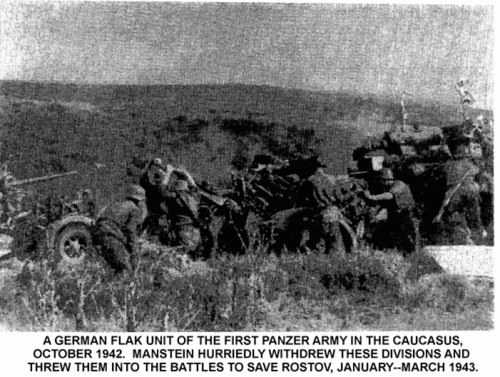
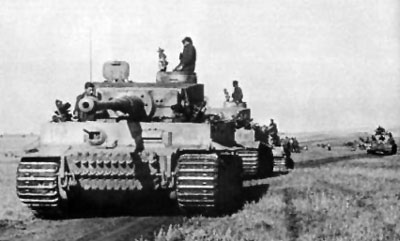 Tiger Tanks assigned to 1st SS Panzer Division
Tiger Tanks assigned to 1st SS Panzer Division 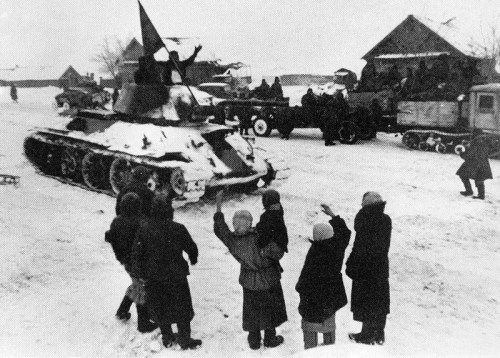 Soviet formations advance
Soviet formations advance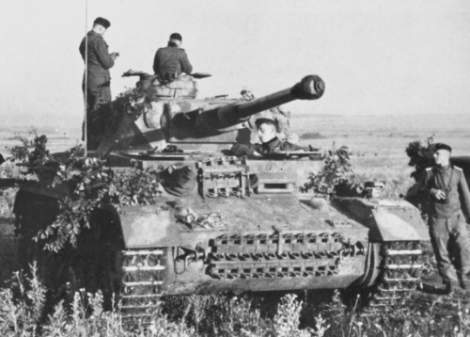 Panzers assembling to attack
Panzers assembling to attack SS Panzers in Kharkov
SS Panzers in Kharkov Hitler’s FW-200 Prior to his Ill-fated vist to Army Group Center
Hitler’s FW-200 Prior to his Ill-fated vist to Army Group Center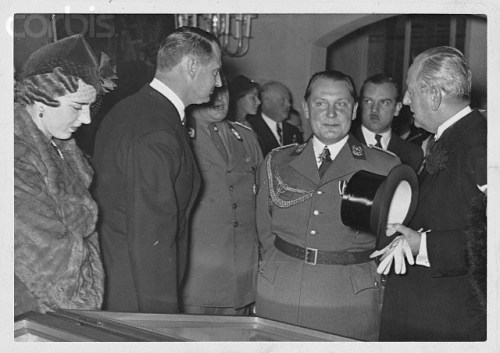 Goering meeting Diplomats following Hitler’s State Funeral
Goering meeting Diplomats following Hitler’s State Funeral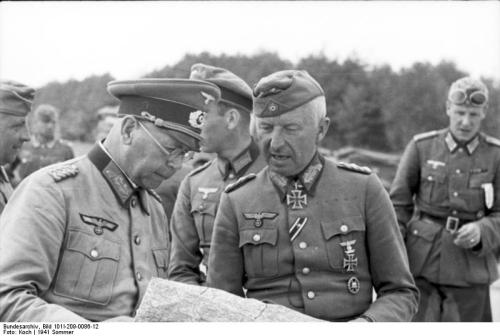 Erich Von Manstein at the Front
Erich Von Manstein at the Front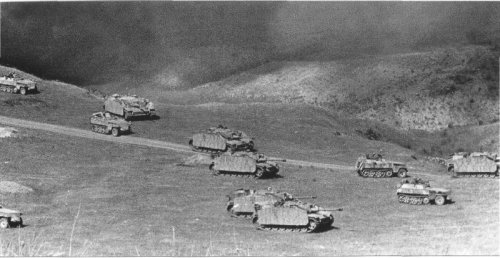 Sturmgechuten and SdKfw 251 APCs moving into position
Sturmgechuten and SdKfw 251 APCs moving into position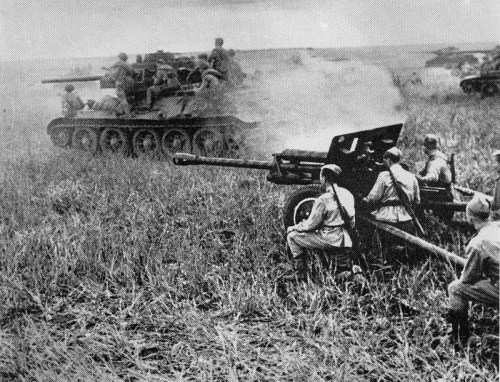 Soviet Tanks and AT Guns at Kupiansk
Soviet Tanks and AT Guns at Kupiansk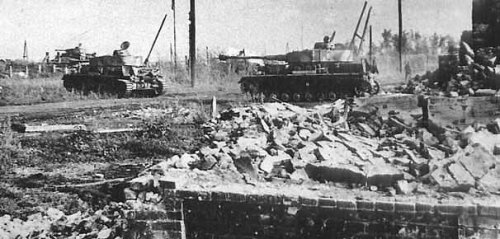 Mk IV Panzers
Mk IV Panzers 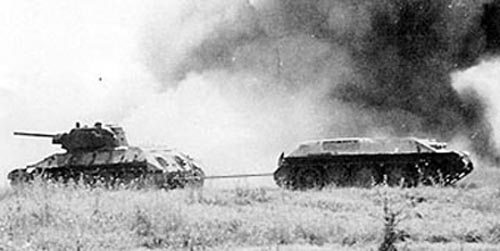 T-34 towing disabled T-34 near Orel
T-34 towing disabled T-34 near Orel SS Panzer Troops and Tigers prepping for battle
SS Panzer Troops and Tigers prepping for battle German Tank Commader as Panzers mop up
German Tank Commader as Panzers mop up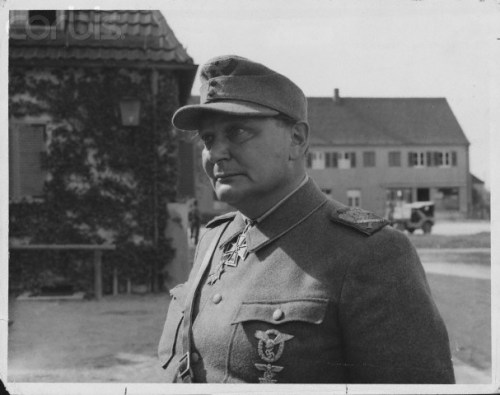 Goering Surrenders himself
Goering Surrenders himself 